UX-strategy in practice. Part 4 - From Design Team to Design Culture

In the first three parts, I described the general approach to the UX-strategy , the suitable designer for its implementation and the result of his work . This is a detailed manifesto - where and how to develop so that the strategy can work at all three levels - operational, tactical and strategic. It's time to put this into a working mechanism, i.e. coordinated design team. How to work at the operational level and achieve tactical success in order to approach the strategic goals of the company?

Five to seven years ago, I would write about the workflow - what stages of work does the design task go through, so that we can understand what and how to do, and then transfer the result to the development and follow the quality of implementation in the process. But the last decade has passed under the sign of transition from waterfall models, first to agile, and now lean. Not that the meaning of our work has changed - it is still important for us to understand what users need and to find a successful design solution for their needs. But the format of involvement in the production process and the worldview as a whole have radically changed.
There is a constant change in the format of interaction and their adjustment to a specific project and task. It is impossible to strictly adhere to the ideal design process - we must be adaptive, like the modern web. Rather, they help out the values we focus on and share with the product team.
')
Article written for the magazine UXmatters .
What to do?
In order for the modern world to successfully fit into a dynamic production process, and the company could work in the market vigorously, updating products and offering new ones, you need to take care of three things:
- Team What is important is its composition and organization principles.
- Leaders . What is important is their vision, authority and responsibility.
- Culture Its construction is a guarantee of long-term and harmonious development of design.
The design workflow is also important, but it has become a hygienic requirement - it is an indispensable, but far from sufficient condition for a strong design team. It must and must be thought out. But for success, shared values are more important.
The process is needed as a guide, not a bureaucratic obligation - it eats up time and motivation. It will change frequently. The main thing - to fit well into the overall production chain. If it has problems that interfere with the implementation of high-quality design - you need to intervene in related processes.
Denis Petelin says that a company with up to 10 people is managed primarily by delegating tasks; up to 100 people - by delegating responsibility; up to 1000 - positive bureaucracy (processes, indicators and goals); up to 10,000 - values and culture. All these management tools are needed for companies of any size, but the focus at each stage of growth is different.
Team
How to pick up
In the second part, I talked a lot about the product designer - a modern specialist who is ready to take responsibility for the product and not be limited to just one title skill (research, visual design, information architecture, interaction design, etc.). For a strong team we need just such people - the only way to achieve worthwhile results. Now it is difficult to hire a strong focused person for each specialization - transaction costs are high. Communication becomes complicated, details are lost, work slows down. It is better to have several people of a wider profile who together will give the right combination of skills. I described their common set in the second part:
- Analytics
- User research
- Information architecture and interface design
- Visual design
- Front end
- Content Strategy and Copywriting
- Quality control
- Marketing and PR
- Project and Product Management
- General skills
In general, the classic T-shaped skill description model. Brad Frost gives an excellent analogy with the legs of the table - there should be several of them so that the design does not fall apart:
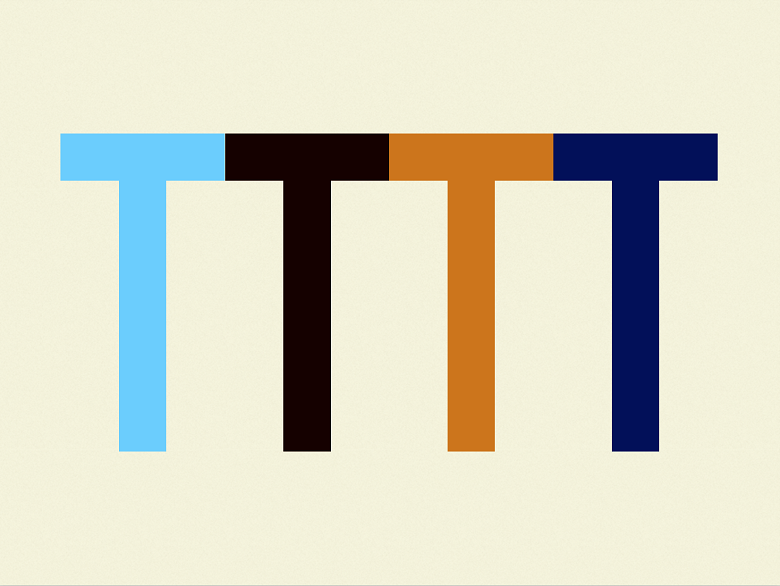
True, they are already talking about M-, E-, Pi- and [substitute any letter] -shaped models , but the principle is the same - you need a bunch of designers who are strong in different skills. Moreover, designers always have a lurch either towards systematization or towards creative solutions. The first will be boring, and the second solution will turn into a monster when scaled. Separately, they will rest on their own limitations, but together they will make a powerful breakthrough.
The action plan is generally as follows:
- Determine the current and desired team profile.
- Highlight skills that are underdeveloped or absent.
- Decide how to pump them from existing designers or hire new ones.
To understand the current capabilities of the team as a whole, it is necessary to evaluate the specific skills of each designer (for example, interface animation or expert assessment). Here will help the classic matrix of skills:
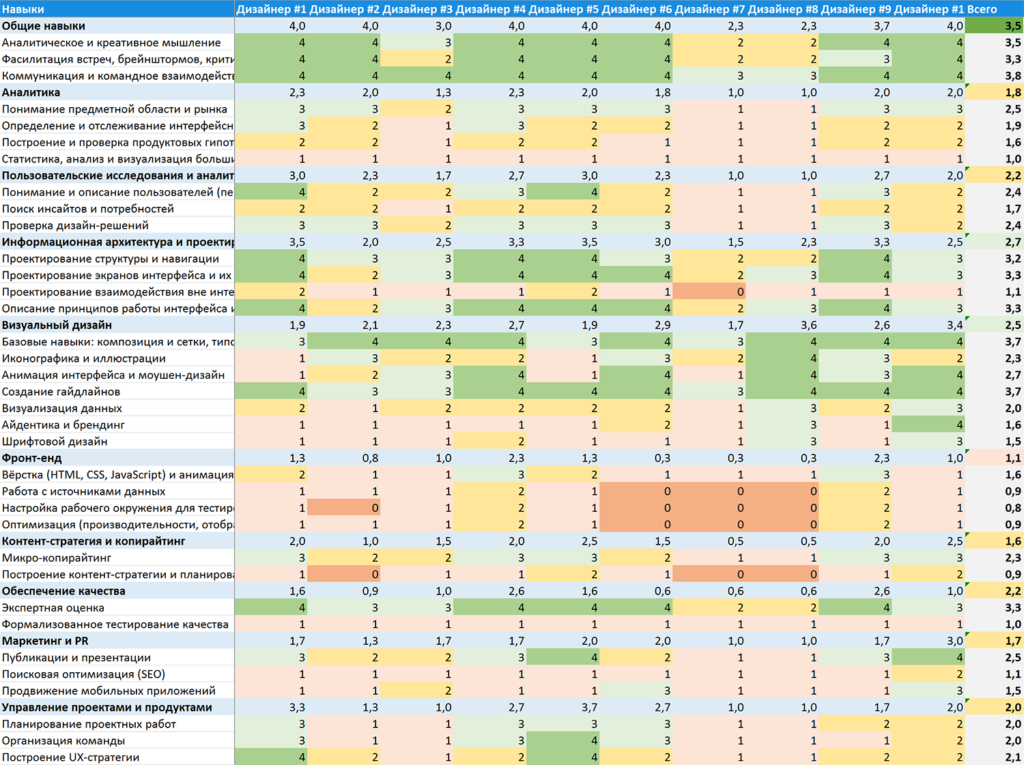
Matrix of skills and knowledge. Download
For each of the skill sets, I see four levels:
- Awareness - understanding how a specialist works in this area. What tasks it performs, what is the workflow and tools, methods and practices, what features and limitations are imposed on it.
- Ability - the ability to solve basic problems in the field. Finish a not very important piece of work for a leading expert, assemble a mock-up or prototype based on other people's work, bring meaningful improvements to an existing document, etc.
- Expertise - perform most tasks in the field of knowledge. From start to finish and, often, on their own. Ability to understand an atypical situation.
- Leadership is the ability to transfer expertise to other team members. Assistance in training and professional growth of colleagues, development of tools and work methods, increasing the overall design culture. The ability to point out a problem situation in a project or process and help solve it.
Nathaniel Davis told a similar approach on UXmatters:
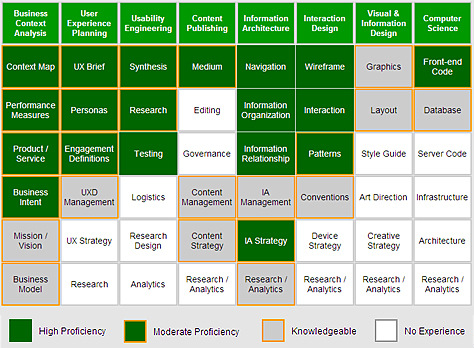
Nathaniel Davis skill model
Contiguous use at Intercom :
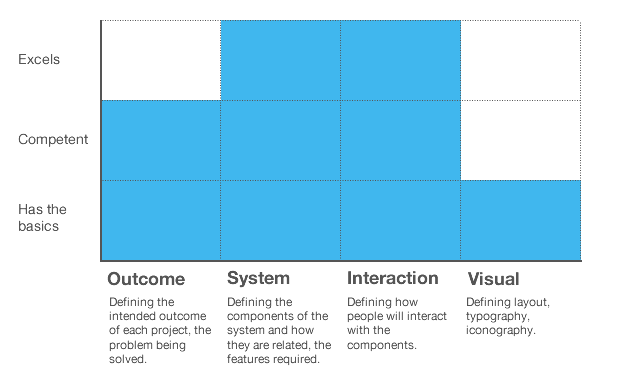
Intercom skills model
For the development of the team, you need to understand what goals the company is facing, and coordinate with long-term product plans. We solve business problems with design. Depending on their set now and in the near future, you need to select people by a combination of experience and skills. Growth points are marked in the current command profile:
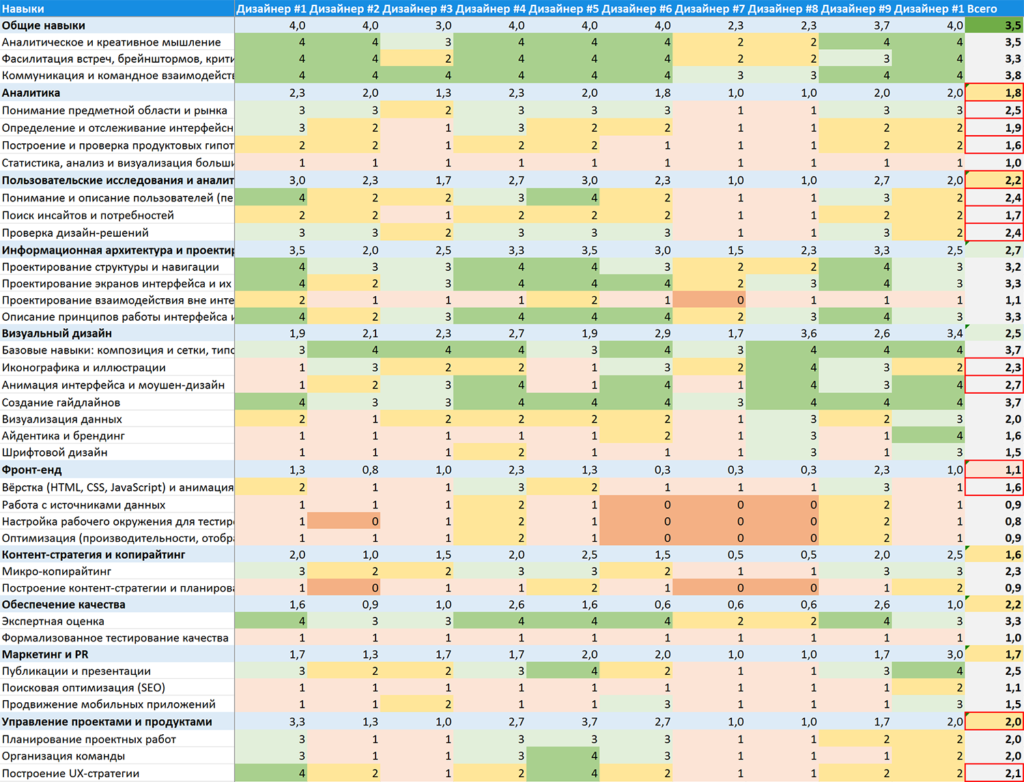
Matrix of skills and knowledge with points of growth. Download
So, we need to pump the existing team in these areas or hire new people with such experience. And if on the contrary, some of the skills are already quite strong, when hiring new designers, you can reduce the incoming requirements - they can pump these skills inside the company. But it will be possible to choose people with unusual experience that will enrich the team.
In general, it is very important to do so that the skills “spread out” within the team — strong people in some direction transfer knowledge to others. This is greatly helped by pair work on tasks, as well as situational work groups. For example, one of the designers sets the direction for a new approach to application icons, while the rest learn from him.
An alternative team planning method is proposed by Nick Daze. Every designer has a professional profile showing proficiency in a set of skills. As it grows, the chart occupies an increasing area:

Skills of designers of different levels
A similar model describes the product team as a whole - product managers, designers and developers:

Skills in the product team as a whole
If the profiles of all employees are combined, you get a portrait of the team as a whole. The white spot in the center is the result of imposing the skills of all three key competencies of the product team, i.e. what everyone knows and can do. John calls him an indicator of her health. True, for a detailed analysis of skills, it did not suit me - the petal diagram has too many rays.
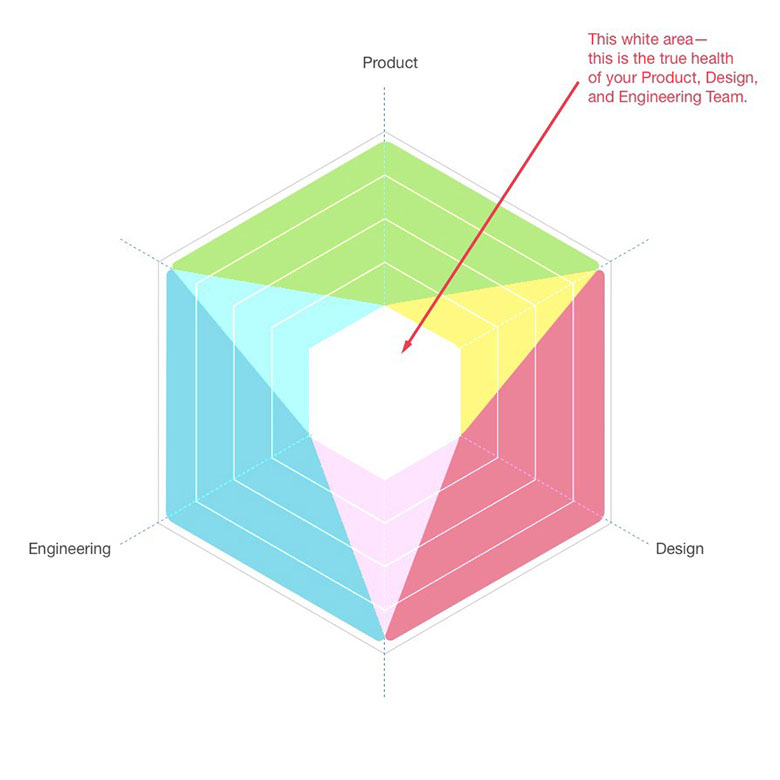
Strong skills in the product team as a whole.
General guidelines
Although I just talked a lot about the selection of skills, when searching for designers it’s better not to focus on them. Strong professionals can be hooked on with interesting challenges and complex problems, and not like any other ad listing requirements, so put emphasis on them in the job description. And about the skills you always have time to talk at the interview and see them in action on the test. Jay Kaufmann has written about this very well.
Another interesting aspect is getting designers into the internal culture. It is extremely important to understand what values the new employee shares. This has a great effect on the final product, especially for young companies. On the other hand, it should not be like a sect or army with complete unanimity - people with a fresh outlook and attitude to work can strengthen the team. The main thing is that this fresh stream eventually merged with the general vision, correcting it, and not starting to loosen you.
Many companies put a benchmark on the ratio of designers and developers in the company. In itself, the number of heads does not mean anything, but such figures may be another indicator of maturity. Leah Buley did a powerful study of how design teams work and got a median of 1: 6. The best companies have 1: 4, and the absolute minimum for harmonious development is 1:12. IBM talks about similar values - an average of 1: 8, although it all depends on the complexity of the product; in the new team of the mobile application, this can be 1: 4, and those who are engaged in complex corporate software with a large server part have 1:12; The number of net front-tenders is approximately 1: 1. According to IBM’s experience, a lack of designers forces developers to solve these problems.
Team organization
The second question is the organization of the team. How exactly the designers will be included in the overall production cycle. The most familiar and understandable two - centralized and immersed. Both approaches have their pros and cons.
1. Centralized
In fact, we create an internal design agency that solves the tasks of several products at once. When it works:
Pros:
- It is easier to maintain consistency between products due to the active exchange of developments.
- You can hire fewer people . Products develop in cycles, the designer has a strong and weak load. One person can lead 2-3 projects - one in the active phase, the rest in support.
- Active exchange of information within the team, so that designers grow professionally with great speed.
- Designers in a natural environment are more motivated and easier to keep.
Minuses:
- The designer is less involved in the product , because it sits apart from the team.
- Not all projects receive design on time due to the fact that the designer is engaged in several at once.
2. Immersed
The classic format for startups and many product companies - the designer is inside the development team. The pros and cons here are largely inverse to the centralized approach:
Pros:
- The best immersion in the product - the designer sees in detail what is happening in all its aspects (interface, business, technology, restrictions).
- More rapid response to any requests. Turning around and asking for something is much easier than trying to catch a person from another office. Which is exactly at this second went to call.
- Feeling elbow with the development team. Participation in all meetings and spontaneous conversations, understanding of all nuances and pains.
- You can do not only urgent tasks, but also think ahead , experiment more often.
Minuses:
- The designer is growing more slowly as a designer, because the exchange of experience with colleagues is sketchy. It is difficult to maintain a uniform level among teams.
- Out of sync product design. Communication between designers from different teams is not as active. Even if there is authority outside, he has less authority on what is happening inside someone else’s team.
- Each team re-learns the experience of erroneous and successful decisions . This is another consequence of the fact that communication teams are not so active.
- If the designer left the company, the team will become bare and the design will stop until a new one is hired. And being out of close design environment, it is more susceptible to fading and de-motivating.
- Not all managers are able to work with designers and even more nervous about their unsystematic nature.
Many companies grow extensively, so the logic of choosing the first or second option is not always there - it just happened so historically. Therefore, in order to optimize, a transition from one scheme to another occurs over time. In some companies they alternate regularly, but this is hardly a good practice.
At the same time in one organization there may be a mixture of approaches. For example, designers are part of a common product team, but the usability lab operates as a centralized agency.
3. Distributed
Centralized and immersed ways of organizing a team imply either / or - the choice of one of the ways of development, with all their pros and cons. But what if you take the best of both worlds? Consciously or not, some companies are moving to a distributed format of the work of the design team and expertise in general.
In essence, this is a matrix management system applied to the design. The designer is in the project team and works with the product manager. And in a more freestyle manner, it is included in the functional, where there is either a specific design manager, or a working group of designers from different teams. What is characteristic of the format?
Part of the product
Designers - part of the product team, are inside it. This allows them to deeply understand the product, quickly respond to all requests from the team and gain credibility in making difficult decisions.
... and cross-functional interaction
Good design works at all levels - understanding of users' problems and business goals, design and product design, their good implementation in practice, filling with high-quality content, smart marketing, caring user support, brand enhancement. These are the specialists with whom you need to learn to interact directly and build horizontal connections - only in this way the final product will be admirable.
Mutual language
The pledge that designers from different teams will be able to issue consistent solutions with a single visual style and principles of work. What can be considered such a language?
- High-level design principles, tying the image of the brand with specific solutions;
- Specific visual solutions: grids, typography, color palette, basic interface components.
- Principles of information architecture, interactions and specific patterns.
- Communication in the interface text, animation, illustrations, marketing and promotional materials.
- Typical approaches to the tasks, methods and practices tools.
... and a feeling of elbow
Do not send each other behind in a potentially conflicting situation. Or even replace the departed from the other team just in case.
Responsibility is wider
In addition to the product tasks, each designer assumes responsibility for one of the parts of the overall style and logic of the interface - that same common language.
He is responsible for ensuring that all products correspond to the guidelines in a certain aspect - by type (visual language, icons and illustrations, advertising formats, animation, etc.), platform (web, mobile web, Android, iOS, Windows Phone, smart clock, etc.), areas (interface or process solutions) or another principle. So it tightly communicates with designers from other teams. For many, this is the first management experience that will come in handy in the future.
Situational Working Groups
A powerful tool for solving general-purpose tasks. These are temporary teams that are assembled for the necessary skills based on a specific problem. This allows you to solve atypical problems quickly and without restructuring the organizational structure.
Mobility
Designer conditionally tied to the workplace. He can work in the product team or move to other designers to solve problems throughout the product line.
... and comfortable working environment
The workspace should help professionals work efficiently and creatively in the product team and in the design environment. These are easily accessible places for discussion and brainstorms, demonstrations of concepts and mindboards, collection of ideas and ideas.
Friendship
A large number of common activities between the designers of the company allows you to boil in a narrow professional environment, retain motivation and shape those common values. Knowledge sharing, beer, common unification tasks, brainstorms on the topic of future development, etc.
To sum up the advantages and problems of a distributed approach:
Pros:
- Being inside the product team, the designer better understands it and the product itself, and also interacts cross-functional more often. More trust and authority, faster reaction time .
- The consistency of the product line is maintained. A common visual language is being developed, various product teams are being synchronized.
- A more interesting, fresh and dynamic work format for designers, and they love everything new.
Minuses:
- We need strong design managers to make it work.
- Need understanding from product managers . They should not overly pull the blanket over themselves, loading the designer by 100%.
- A sufficient level of maturity of the company is required - basic work processes are established and there is an understanding of the importance of design.
- It does not give an answer for geographically separated teams , although it is useful in this case too.
Also, there is competition between product challenges and common product line unification. Depending on where the designer is sitting now (in the product or with other designers), his implicit priorities depend - he considers this working group more important and gives it more attention.
KPI
Should I use KPI for designers? The simple answer is no. The final specialist indirectly affects the release of the product, it is difficult for him to be responsible for the overall result. And if you also attach a salary to this, you get a constant source of discontent - the influence is small, and the ruble is constantly beaten, often for other people’s packs. In the end, it all degenerates into an artificial structure that gives more harm than good.
But if you give the designer managerial responsibilities, then KPI will be appropriate. Also useful are the internal indicators of the health of the team - whether we fit into the plans, whether there are any complaints in terms of quality. For a particular specialist, you can look at whether he develops, how often the pack is ready, whether he is ready to spend a little more energy than is necessary for the product to go out steep and in time. But the latter is simply the work of a design manager, for which no KPI is needed.
Examples
James Kalbach offers a good concept for the team - he cites jazz improvisation as an example . It is based on similar principles:
- Empathy within a team that allows you to hear and understand what others are doing.
- Acceptance of the variability and uncertainty of projects and the working environment, which facilitates experiments and the search for new solutions.
- General techniques and methods that glue the initiatives of each of the participants together.
James vividly illustrated this in his mini-talk at TEDx:
Baruch Sachs says the same thing - despite all the planning and strategies, teams and business leaders have to constantly improvise, as the surrounding technological and business environment is constantly changing. And many companies find unconventional approaches to the work of design teams.
There will be a lot of examples, so you can run this piece diagonally.
Modern matrix structures
Spotify
Guru agile Henrik Kniberg and Anders Ivarsson worked for the company an interesting organizational structure , where employees are divided into 4 groups:
- A squad is a full-fledged mini-team responsible for a certain piece of product (for example, a block of recommendations in an application).
- A clan is a group of units that work in interrelated areas (for example, a player or back-end infrastructure).
- Department - all employees of a particular specialization in the clan (for example, designers).
- Guild - a community of specialists throughout the company dedicated to a specific topic (for example, web technology).
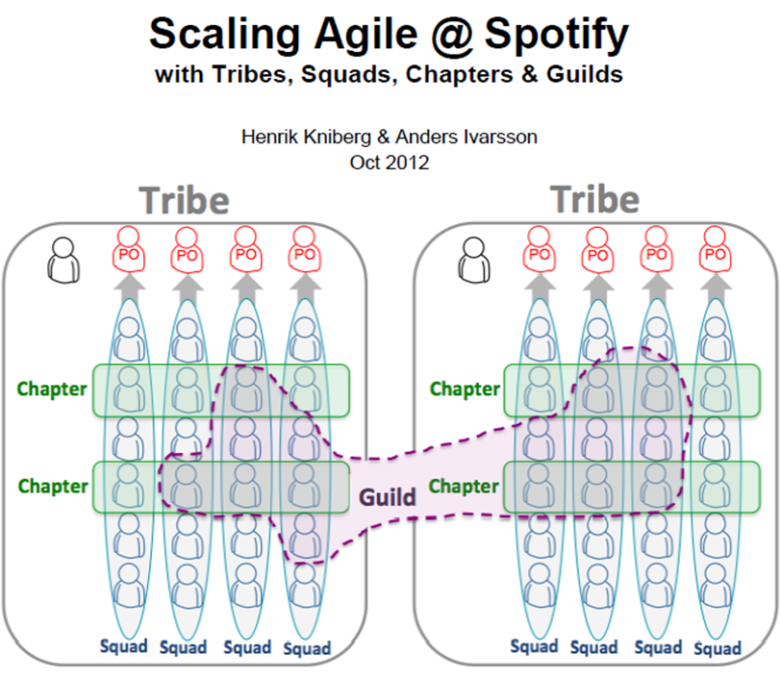
Spotify command model
The head of a department (for example, design) is a line manager for his employees, who is involved in grocery work in order to remain “in the subject line”. Guilds have coordinators. They are the leaders in terms of competence and are responsible for ensuring that each specialist does his job well. In this case, the product manager is responsible for what the employee will do, this is an internal entrepreneur. There is an internal conflict - the first try to do everything right, the second - quickly, but it just allows you to find a balance.
The company is divided into two types of commands - functional (profile, media content, search, etc.) and platform (web, Android, iOS). The update gets into the product only if both agree with the decision. Those. the function works equally on all platforms, without destroying their identity.
Adobe
Photoshop team is divided into holistic teams responsible for specific product functionality. They are called “molecules” and are made up of designers, developers, and managers. In many ways, this was the result of the transition to the SaaS business model, when, instead of major releases, every couple of years the product was updated every six months, or even more often.
Since Photoshop is intended for a rather diverse audience (photographers, designers, and other creative professionals), it was important for researchers to establish a fast channel for communicating with users and getting feedback from them. Product designers have access to this community on Slack and Facebook, so they can check their solutions and look for still unsolved problems.
Multidisciplinary design team
Mailchimp
When the company was founded in 2008, Aaron Walter was the only designer and he was involved in everything — design and interface design, front-end, and user research. This helped him to understand how to build an ideal design team - interdisciplinary, avoiding transaction costs. In 2015 there were 12 people in it - 4 researchers, 2 product designers, 4 front-enders, a mailing list designer and a manager.
The team is mobile and people regularly transfer to developers, marketers and other specialists to solve a specific task. In addition, the office has a guest space where prominent industry experts like James Victore and Brad Frost regularly come in - it charges designers great. In addition, Mailchimp employees practice the work of all professionals in the customer support department . Such stimulation of interdisciplinary communication helps great product development.
FiftyThree
The company produces the popular Paper application for drawing on the iPad, which is known for its interesting and engaging interface, often breaking traditional solutions for similar products. To do this, they often need to prototype unusual approaches, so there are three strong designers in the team with quite good development experience who are engaged in constant experiments. , , .
, Pioneer Studios Microsoft, Courier. Andrew S. Allen, - Paper, , , — - .
Fruit Ninja
. , — , — , , . , , . , «» .
Groupon
- , — , , .. . « ». - Mail.Ru Group .
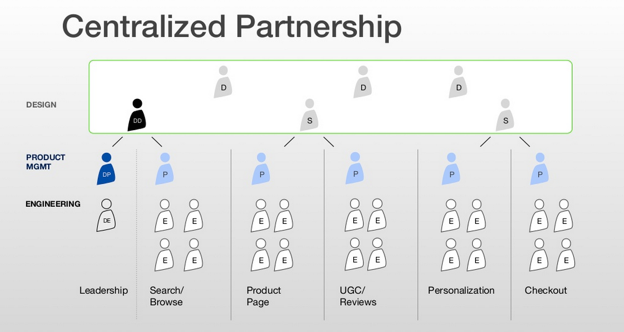
Groupon
Netflix
- , -, . 4 :
- Mobile and Tablet
- - ,
«», «» — , . - , , .
, - -
2013 , «Project Kennedy», UXA . - , . — .
Ibm
, $100 1000 . 400 000 . - (), , , . — - , «» , - . — .
Vox Media
- — , , , . — .
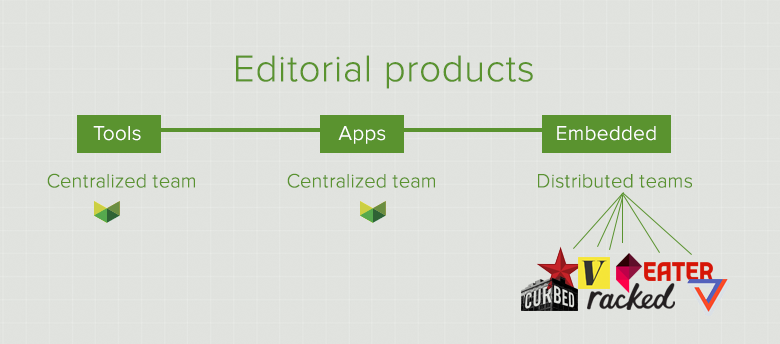
- Vox Media
, . — , . , -, , .
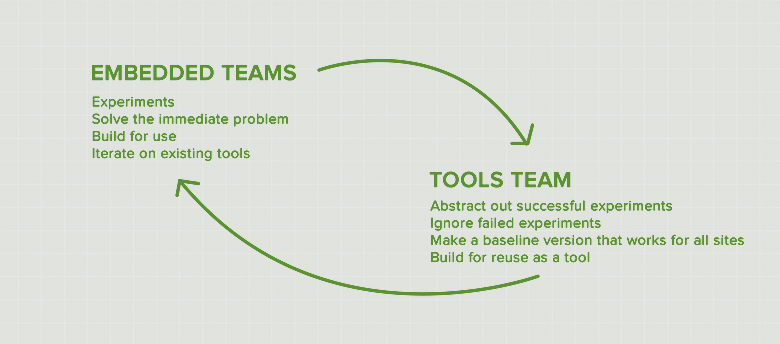
- Vox Media
Nathan Curtis EightShapes . — , . , .

Nathan Curtis
CEO
Apple, Olivetti, Braun
, CEO Steve Jobs Jony Ive. , . , Olivetti Braun, , , . , .
— John Maeda (KPCB), Irene Au (Khosla Ventures), Jeffrey Veen (True Ventures), Google Ventures . — - .
— . — , Valve, Medium Buffer . — , .
Zappos — 14% . , . — , . , .
, - Alexander Osterwalder. , . , .
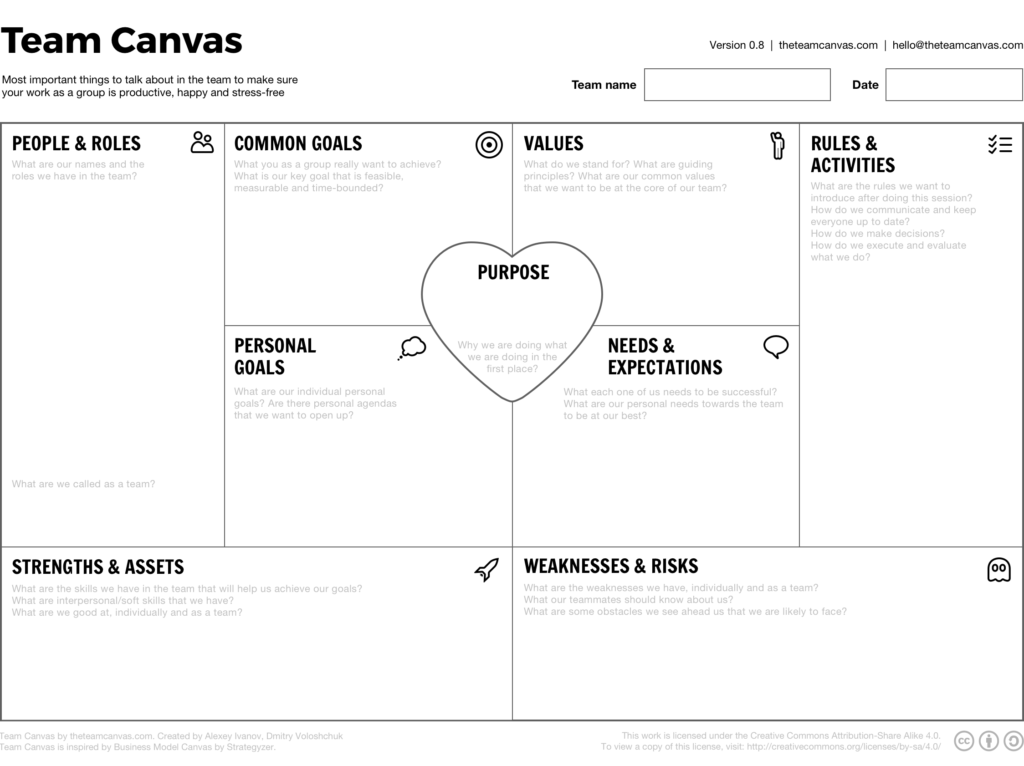
Team Canvas
. , - . , . , .
— ( , , ), - -, -.
— -, , . .
The leaders
. « » . , . -, . . -, , , — .
— - -. , . .
. , . , :
...
, , . , , . , , . , - — .
… -
. , . , .
, — . : , — .
, , , . , . . — . .
…
, - . , . , .
. , . - — .
. - — . — , . , .
, . , . , , , , . , .
,
, , , . -, , , . - — . — , , . , .
And, of course, the basic requirements are responsibility, consistency, interpersonal skills, effectiveness, resistance to stress, etc. An excellent series on this topic is written by Jim Nieters and Pabini Gabriel-Petit ( second part ).
Immature managers often think about their indispensability - they say, if the company lets him go, everything will fall apart. Particularly touchy even begin to spoil, if the relationship did not end as desired. This is a short-sighted and weak-minded train of thought. If the leader truly believes in what he is doing, he will build the processes and the team so that his vision continues to be implemented even after he leaves. Otherwise, all efforts were useless and he just spent in vain several years of his professional life.
Interproject Working Group
It is difficult for one leader to work effectively at all three levels - operational, tactical, strategic. Each requires powerful immersion in order to achieve strong results. And also - a bit contrary to the rest. For example, the designer at the operational level seeks to make the layout perfect. Although at the strategic level, the question arises whether we will be able to implement this function in the near future and we just need a rough sketch to test the soil. One person can balance this, but there will always be distortions.
We need leaders responsible for different levels of design:
- The general direction of development of design in the company and its product line.
- The level of specific products as they develop.
- The level of cross-product solutions for the unification of design (icons, animation, mailing letters, etc.).
One of the main theorists of management, Yitzhak Adizes, offers the PAEI model for characterizing managers. To successfully manage a company, we need four components - production, administration, entrepreneurship and integration. However, a particular manager in itself is inclined only to some of them, so that he cannot effectively close all the needs of the organization. And we need a bunch of several managers in order for the company to live and grow harmoniously.
If you remember that a leader is first of all a function, and only then a position, then you can avoid building a complex hierarchical structure. Close all three levels of design in the company will be able to effective inter-project working group. Everyone is afraid of isolation within the organization at the level of functions. But product-level isolation is also bad for a company with their portfolio. Therefore, such a working group will work well for creating and implementing uniform guidelines for the entire product line.
In general, as well as for organizing the participants of the design team, for effective interaction of design leaders within the company, individual approaches and formats are needed.
Culture
If you build a healthy design culture with the right values, it will take the quality of products to a new level. Then your design team will be the entire company, which, with its entire mass, will move the level of design forward. This should be a common vision that everyone shares and everyone tries to embody it on his own level.
We must reach out to every manager, developer, tester, marketer. Explain what we do and why in terms of design; what goals we want to achieve and where we are going; what is important to take into account always, and where passed by not one hundred organizations of a rake. They need to understand what we are doing and why to be on our side and support us.
As this work with non-designers, there will be empathy with designers for them. This means that communications within the company will become generally closer and more useful. Developers will be more willing to talk about the technologies used and restrictions, managers will more often share road maps, and designers themselves will become more imbued with respect for each other. The transparency of work will increase, there will be more trust in all directions, and there will be less small jambs, so that each of us can focus on higher-level tasks.
Problematics
Consciously or not, there is a certain culture of relationships and grocery work in any company. About some of them tell inspired stories, some portray in caricatures.
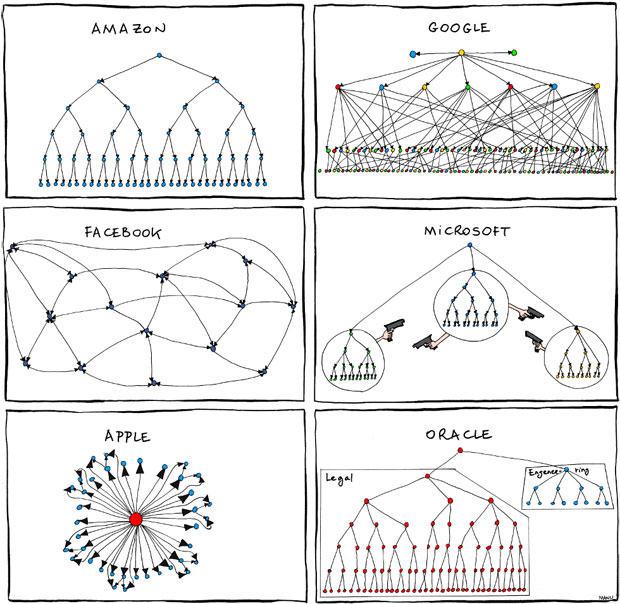
Caricature about organizational models of famous companies
Everything is easier in startups - there is no heavy legacy and you can immediately implement healthy values. But they don’t have time for this either, so most of the existing organizations will have to try. Conway law says the company reproduces its own organizational structure in product design. It is often a product of chaotic growth and reorganization, many compromises, crises, and forced decisions that accumulate in organizational debt .
Although it is not in the power and beyond the competence of the design managers to change the entire structure of the company, product design depends on the solution of many organizational problems. It is useful to rely on a model of problems in the work of the teams of Patrick Lencioni , the famous management theorist:
- Distrust due to feelings of insecurity.
- Fear of conflicts that are useful because of the desire to preserve artificial harmony.
- Lack of dedication due to general ambiguity.
- Irresponsibility due to communication discomfort.
- Indifference to the results because of the pursuit of personal goals and status.
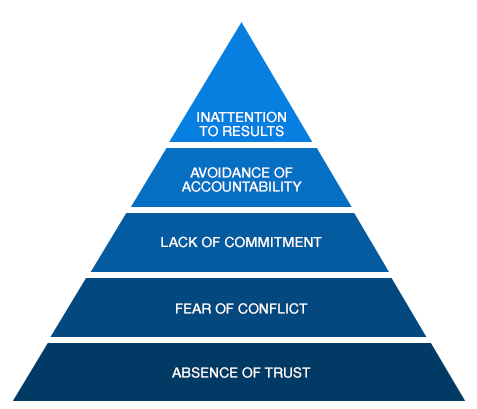
Model problems in the work of teams Patrick Lencioni
It helps to understand why designers are faced with a strange or cool attitude of colleagues when trying to promote complex, but important decisions. And this is halfway to success.
What problems will the design team solve with the introduction of a healthy design culture?
The quality of products is higher
If you train managers, developers, testers, marketers and other specialists in basic rules and principles of good design, they will be able to distinguish the good from the bad and be our eyes and hands at your level - at least not make mistakes on our own, and even better - show us on our flaws.
Design implementation bugs are the scourge of any development process. How to reduce them?
- Design system - I talked about it in the third part of the series.
- Competently built process , where there is a good quality control mechanism and mandatory design review.
- Expert assessment by the next participant in the production chain, which we have never perceived as a designer. It will earn thanks to the culture.
Roles and specializations in the product team in any case intersect - the coder will help solve the designer's mistake, and the designer - what the product manager has forgotten. To do this, you need to understand the specifics of the work of related roles in the product team, to act as a mentor and source of knowledge for them. And the most important thing is not to be fooled with authoritarianism in making decisions, admitting colleagues from other professions into your professional territory. In poorly integrated teams, this is a source of gaps, but one can benefit from these intersections - each improves the quality of the work of a colleague, and hence the entire product.
More fresh thoughts
Culture will help and when developing new functionality or products. Approaches to working sessions, better offers and trend awareness will make non-designers more useful.
It is important to organize the exchange of knowledge. We know a lot about users and their work with interfaces. In many ways, we are appreciated by managers and developers. Patterns and best practices, methods and techniques, guidelines and standards, stories of successful and failed launches, research and facts - all of these need to be shared with colleagues, and even better collected for later use. Aaron Walter talks about MailChimp 's systematic approach to systematizing user knowledge and design.
And if you also go together for custom research and testing, you can develop in your colleagues empathy and a sense of responsibility for design solutions. And clearly show how controversial proposals lead to real problems. Well, over time, learn to look for ways out of these situations together, often right in the laboratory. A useful indicator for this is Jared Spool, the “flying hours” of user observation . He recommends at least 2 hours for one and a half months for each employee of the company.
Of course, the developer or manager can not and should not know the whole amount of knowledge on design. But the higher their basic level - the easier it is for you to communicate in one language. Yes, and agree on complex issues will become easier. At the same time, designers will not become unnecessary - on the contrary, due to a common understanding of the perspective, their value in the eyes of colleagues will grow.
Medium resistance less
The team gets credibility and credibility. People constantly listen to it, come with problems, but not ready-made solutions. And not only managers, but also final specialists - developers, layout designers, testers. It develops horizontal connections that are critical for long-term success. Remember that you are a team not only among designers, but also with the entire company.
It’s impossible to get rid of conflicts completely - colleagues will always look for a simpler and cheaper way to accomplish tasks, and time will be tense and not let them do it. But their frequency and intensity will constantly decrease.
Healthy habits
A change in culture goes through a change in attitude and behavior in the company regarding design. It is better to start with the introduction of correct practices and healthy habits that will lead to new values. It is useful to formulate a list of such habits and begin to regularly cultivate them. Moreover, the company expects from us, first of all, results, and not just a large-scale organizational progress, so we still have to act with small victories. By the way, for the beginning they should be supported within the design team - it is difficult to propagate values that you do not share yourself.
What healthy habits will help to feel and accept values?
- Share knowledge. On professional topics, the results of product launches, analytics and research.
- Make product decisions together in conjunction with a product manager + designers + developers.
- Do not criticize colleagues for mistakes, but draw conclusions from problem situations and not repeat them.
- Give balanced feedback, highlighting the strengths and weaknesses of solutions and approaches.
- Keep the results of your work open and always accessible.
- Explain the logic of decision making in their professional field.
- Promptly respond to questions from colleagues and help them solve problems with the implementation and development of design.
- Develop horizontal communication - communication of specialists directly, bypassing managers.
- Arrange pair working sessions when a designer and a specialist in another subject area together solve a computer task.
- More often talk about the success of design and successful implementations, as well as the positive contribution of designers. To motivate the company's management, supporting the design, to talk more actively about it. Other managers will seek to replicate this experience.
- Record decisions made at meetings and stick to them. Ideally, to describe both discarded options, as well as decision logic.
- Always keep learning and developing professionally.
This list can be continued with things important for your company. The task of the design team is to constantly remind of these good practices until they reach automatism.
This process is not very fast - it takes a decent amount of time for a habit to take root. In this case, you need to give the result here and now, without waiting for the improvement of the situation. Unfortunately, in the early stages you can lose part of the design team - not everyone is ready to go through a difficult early period of chaos. But the healthier the culture becomes, the more powerful specialists can be attracted and the more motivated the whole team will be.
It is always useful to look at what habits and values promote well-known design teams. For example, ustwo adheres to the following principles :
- Joy is more important than stress.
- Flexibility is more important than structure.
- “We” is more important than “I”.
- Unseriousness is more important than seriousness.
- Collaboration is more important than hierarchy.
- Courage is more important than comfort.
- Principles are more important than results.
Spotify says a healthy culture will help smooth problems in the process. This is the right balance between chaos and bureaucracy.
Co-design
One of the best ways of pumping design culture. Any more or less serious functionality, and even more so a new product, is thought out by a small working group - product manager, designer, lead developer. This is a mini-workshop where:
- Requirements are discussed - it is important to understand whether everything is taken into account. And why is this being done at all?
- Usage scenarios are being developed - how and which users will work with the function.
- Studying competitor solutions - what is the space of problems and solutions?
- Sketches of screens and interaction diagrams are made.
As a result, we go out with a ready-made solution that takes into account all the requirements and limitations. Or a few alternative ways that we want to test. This is better than pointless ping-pong, when the designer and manager communicate inside the task manager, misunderstanding each other and generating tons of unnecessary comments and artifacts.
Managers and developers feel like co-authors. They will fight for him, and not try to change as soon as possible. They see the entire chain of design decisions, discarded options, and also offer their ideas - often really strong ones. And they understand better how the designer thinks and works. There is no longer a single hero who descended from the height of his position and issued a magically working solution - the design was made by the team.
And the designers themselves stop beating until they lose the pulse for their decision - there is no need to prove to everyone that you are smarter than the rest. You will be judged on the success of the product as a whole, and not on specific details in the interface.
At the same time, co-design and design by the committee are different things. It is necessary to minimize the number of participants in the meetings to 3-5 people. Big meetings are needed only to collect ideas and requirements / wishes, as well as to present ready-made concepts. You can not create a concept of a large group of people. The working group has a responsible person who collects the concept from the ideas received.
Some companies practice co-design with users - this is a great opportunity to get feedback faster and increase empathy. Similar ideas have promoted lean research, and in Scandinavia, the approach has been used since the 1960s.
There are several packaged formats for co-design - design sprints, design studios, and other variations on design thinking. And they are practiced not only by grocery companies, but also by modern agencies that actively engage the client in the work.
Design sprints
The five-day teamwork format for conceptual product design from Google Ventures. Their version of design thinking, packaged for specific tasks - the approach copes with the task of helping young startups in which the fund has invested.
- Day 1: Preparation. Exchange of knowledge about the problem that already exists within the company; description of the target audience and use cases; week planning.
- Day 2: Sketches. Outline of ideas, their discussion and evaluation.
- Day 3: Decision making. Determining which of the sketches will go into the work further.
- Day 4: Prototype. Creating a prototype solution.
- Day 5: Testing. Communicate with potential users to test the prototype and individual ideas.
It turns out this model:

Design sprint from Google Ventures
Unlike design thinking, here user research is carried out separately. The format is called " research sprint " and includes 4 days:
- Day 1: Selection of respondents.
- Day 2: Schedule and preliminary interview plan.
- Day 3: Final schedule and interview schedule.
- Day 4: Interviewing and structuring the found insights.
Design studios
A one-day or two-day work session in which participants are divided into teams and work on solving product problems. Main steps:
- Warming up, in which people are taught not to be afraid to make sketches, even if they do not know how to draw.
- The teams prepare the maximum number of solution sketches, and then exchange them.
- Everyone chooses the most interesting idea and works it out in detail.
- Ideas are sorted by customer journey.
- Ideas are discussed, criticized and defended.
- Another stage of refinement of ideas.
- The working group votes for ideas using the KJ method.
Design thinking in packaging
The classic format of five-stage design thinking from Stanford and IDEO is known to everyone - empathy, problem statement, ideas, prototyping and testing. One of the key ideas is the alternation of the stages of divergence (study of the space of problems and solutions) and convergence (selection of the most appropriate options). All or part of it is practiced by a huge number of companies and this is the most popular way to involve non-designers in the design process.
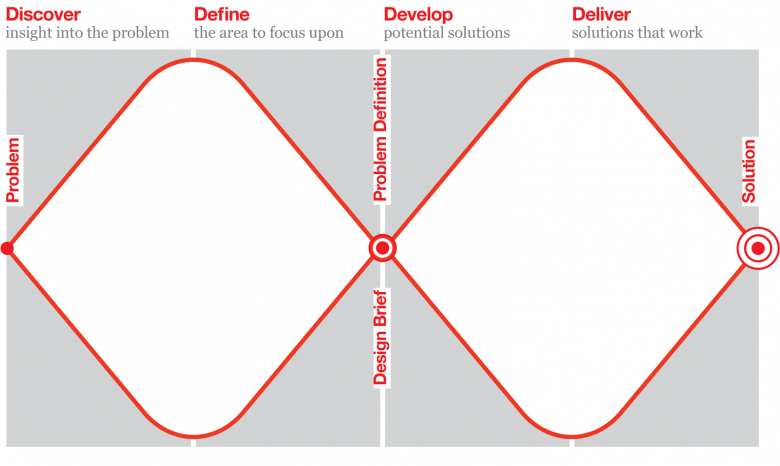
Model of "double diamond" from the British Design Council
Some of them repackaged it to fit their tasks and one of the brightest versions was obtained from IBM . - — , . — -, . IBM :
- « ». .
- . - , .
- . .
-
. — . IBM 350 000 , -. , .
Intuit, - «» «» . - . - . «» 1200 . Immersion — Sparks 10% .
?
, . - — , .
— . , .
Planning
, :
- — . todo. — .
- — . . — , , .
- — . . — , .
— , . - , .
. - , , -. — , . :
- - : , . , .
- , . . , . , .
- , . , . - , - — , .
, , , .
Instruments
:
- , , .
- .
- .
- .
, .
, . — , , …
— , . - . , — ( ). :
- . — , , , - ..
- — , . , .
- , . « » — .
Professional growth
, , . :
- . — , , , ; -, .
- . , , -.
- . — , , , .
- -. - .
, . :
- . .
- . — , , , , ..
- . ? ? , , «» . - , .
— 70%/20%/10%. , . . , — , , .
, . , . , — . ( ), . - , , .
3-4 , . , . !
, — , . .
Total
, . , .
— , . — . , . - , , .
Source: https://habr.com/ru/post/309742/
All Articles